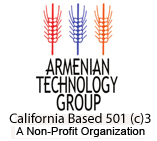Sissian -- ATG Expands Projects in Border Areas
| March 28, 2006
 For additional photos related to this article, visit the ATG Photo Gallery. Sissian, Province of Syunik, Armenia — Alongside a lush, newly sprouted plot of Steptoya barley situated in an open field near Brnagot village, agronomist Gagik Mkrtchyan kneeled and measured the plant growth. “Over 10 years ago, farmers had success with Steptoya in Sissian,” he said. “But I don’t remember seeing a set look this good this early in the growing season.” As a group of farmers, farming professionals, and NGO officials investigated other varieties of barley and wheat in the surrounding sections of land, Mkrtchyan and fellow-agronomist Vaghinak Kamrastyan examined the wheat in the experimental plot, noting the success of two varieties new to Sissian. “Baldasar, a French variety, and Promontory, look great,” Kamrastyan said. “Promontory does well in high altitudes like those here in Sissian.” To the south, high, snow-capped mountains separate Armenia from Azeri-controlled Nakhichevan. “We need to keep these border areas strong,” Kamrastyan said. “To do this, we need to maintain a strong, active agricultural base.” Mkrtchyan and Kamrastyan have worked for the California-based Armenian Technology Group (ATG) since 1994, when Mkrtchyan headed the well-known Wheat Seed Project that provided seed to farmers throughout the country. At that time, ATG coordinated efforts with Sissian farmers Sevada Ivanyan and Araik Tangyan and, in nearby Khundzoresk, with Rudik Sardaryan, who served as ATG’s chief agronomist for the province of Syunik. Currently, ATG is continuing its cooperation with area farmers and organizations such as AGRICO, Agro Holding, and World Vision, whose Sissian director Emma Kojoyan is working with Mkrtchyan and Kamrastyan to strengthen the agricultural base in the area. “Our cooperation began last year, when a project initiated by ATG board member Zareh Misserlian and the ATG-created Seed Producers Support Association (SPSA) helped wheat farmers in the village of Ltsen,” Kojoyan said. “We know SPSA (directed by Mkrtchyan) offers the best seed available, along with new, promising varieties of different kinds of grains, vegetables, and legumes. We are already working with SPSA growers Sevada Ivanyan and Araik Tangyan, who provided the wheat seed for the Ltsen project.” Seed agency initiates projects in border regions Working with a network of SPSA farmers and the Armenian Agriculture Ministry, Mkrtchyan and Kamrastyan have begun planting experimental plots of chickpeas, lentils, peas, sunflowers, and corn in the border zones of Syunik and Tavoush, and elsewhere in the republic. In a small plot in a tree nursery in Tegh, on the Armenian frontier with Lachin, Mkrtchyan, Kamrastyan, and Kojoyan checked the growth of a variety of chickpea provided by Garnik Petrosyan of the Ag Ministry. “This variety, known as ‘Garbs,’ is perfect for this area,” Mkrtchyan said. “As the year passes, we’ll report to Garnik on the progress of this and other varieties. This way, the ministry will have current knowledge about which varieties have a future in Syunik, and throughout the country.” In the nursery, operated by SPSA farmer Samuel Davityan, new and established varieties of apricot, cherry, and apple trees are being cultivated. Walking between the rows of cuttings, Davityan explained the specifics of each variety while workers neatly trimmed several cherry cuttings ordered by a farmer in Ashtarak. “Here, farmers and organizations, such as World Vision, can purchase high quality tree cuttings, which will ensure success for everyone involved,” Mkrtchyan said. “Our farmers will be competitive in the marketplace, while at the same time making border areas like Tegh and Sissian strong. We are also working in the important border region of Shamshadin, in Tavoush, directly on the border with Azerbaijan. There we have planted chickpeas, peas, and lentils, as well as several varieties of wheat and barley.” Before returning to Sissian, Mkrtchyan pointed to the new growth on small plots of green peas and lentils. “Agro Holding, an organization which is involved in animal breeding and the production of dairy products, asked us to experiment with the peas,” Mkrtchyan said. “Although based in Yerevan, their work is centered in Spitak and along the border with Turkey, in the Amasia region of northeast Armenia.” A strong, late-afternoon wind swirled, typical for the time of year in Tegh. “We also plan on experimenting with new varieties of corn and sunflowers, which we will plant in autumn in Tegh and Shamshadin,” Mkrtchyan said. “We received the corn seed from SPSA growers Virab Manukyan and Valodya Khachatryan, both from the Ararat Valley, and the sunflower seeds from Garnik Petrosyan. Working together, we will be able to find out which varieties are successful, and in which climates and altitudes. And, we are already cooperating with SPSA wheat grower Vahan Barseghyan, from Arevshat village in Artik, for seed multiplication of vegetable and legume seed.” Back in Sissian, Sevada Ivanyan and Atom Arakelyan, mayor of Brnagot, greeted the group. “ATG is always welcome in Sissian, and in Brnagot,” Arakelyan said. “In 1999, Roger Culver (then ATG’s in-country director) and Gagik Mkrtchyan provided growers in our village with SN-64 wheat seed (registered in Armenia as ATGF 35-16). The seed is so good, we have used it until today, seven years later. The seed literally saved our village. Now, our farmers are already checking Gagik and Vaghinak’s experimental plot in Brnagot, to see what new varieties grow well here. I especially like ‘Aghtamar,’ a new variety of wheat developed in Martuni, in Armenia.” For more information about how you can help Armenia’s farmers, contact the ATG office at (559) 224-1000 or by e-mail (info@atgusa.org). Tax-deductible donations can be sent to ATG; 1300 E. Shaw, Suite 149; P.O.Box 5969; Fresno, CA 93755-5969. |
|


Follow Us